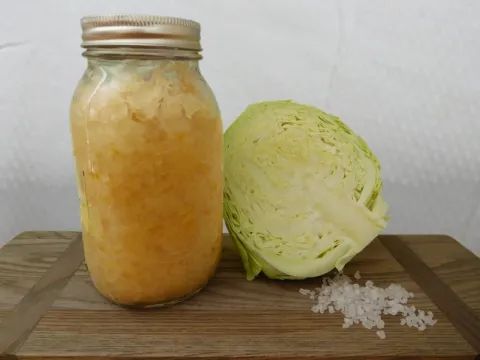
Sauerkraut
By Diane Galvan UCCE Master Food Preserver
“I've noticed fermented foods like sauerkraut are popular. While I'm casually familiar with sauerkraut, what makes it ‘fermented', and is it difficult to prepare?” -Angela B., Atascadero
While we commonly think of sauerkraut as German, origins of this technique can be traced back to China during the construction of the Great Wall, when workers would add rice wine to their cabbage to preserve it. In time, variations of this method were introduced to Eastern Europe according to the New York Times.
The July 2014 edition of Scientific American describes fermentation as food exposed to bacteria and yeasts. In sauerkraut, it's the bacteria – mostly Leuconostoc and Lactobacillus species– that are naturally present on cabbage, which do the job. These bacteria digest sugar in cabbage, and this reaction produces lactic acid, which preserves the cabbage and prevents the growth of harmful bacteria. Lactic acid gives sauerkraut its sour flavor and makes it easier to digest.This fermentation process results in Interesting flavors, textures, and a good source of probiotics.
You can prepare sauerkraut at home with delicious results; just remember food safety is extremely important. According to the USDA:
*Absolute cleanliness of all utensils, working areas - and hands - is a must.
* Use an appropriately large vessel of stoneware crockery, glass or food grade plastic (no garbage bags or trash liners); do not use metal. The vessel should be free of scratches or cracks that can harbor harmful bacteria.
The National Center for Home Food Preservation, which provides recipes rigorously tested for safety and reliability, reminds us:
*Always use a recipe from a reputable source.
*Follow the recipe carefully; accurate salt ratio, temperature criteria and technique-while not complicated - are essential to the safety of the process.
*Good quality cabbage, preferably harvested between mid-august and mid September, yield a good product. Avoid old, tough cabbage. Prepare sauerkraut within 24-48 hours after harvest when possible.
Home preparation of sauerkraut is not difficult, but it's helpful to learn a new food technique by demonstration. Fortunately, just such an opportunity arrives with UCCE Master Food Preservers' public class THE MAD SCIENCE OF FERMENTATION, Saturday, February 23rd. Topics are: Sauerkraut,kimchi, apple cider vinegar,kombucha.
Pre-registration required. For information and registration: http://ucanr.edu/fermentationscience.
.

